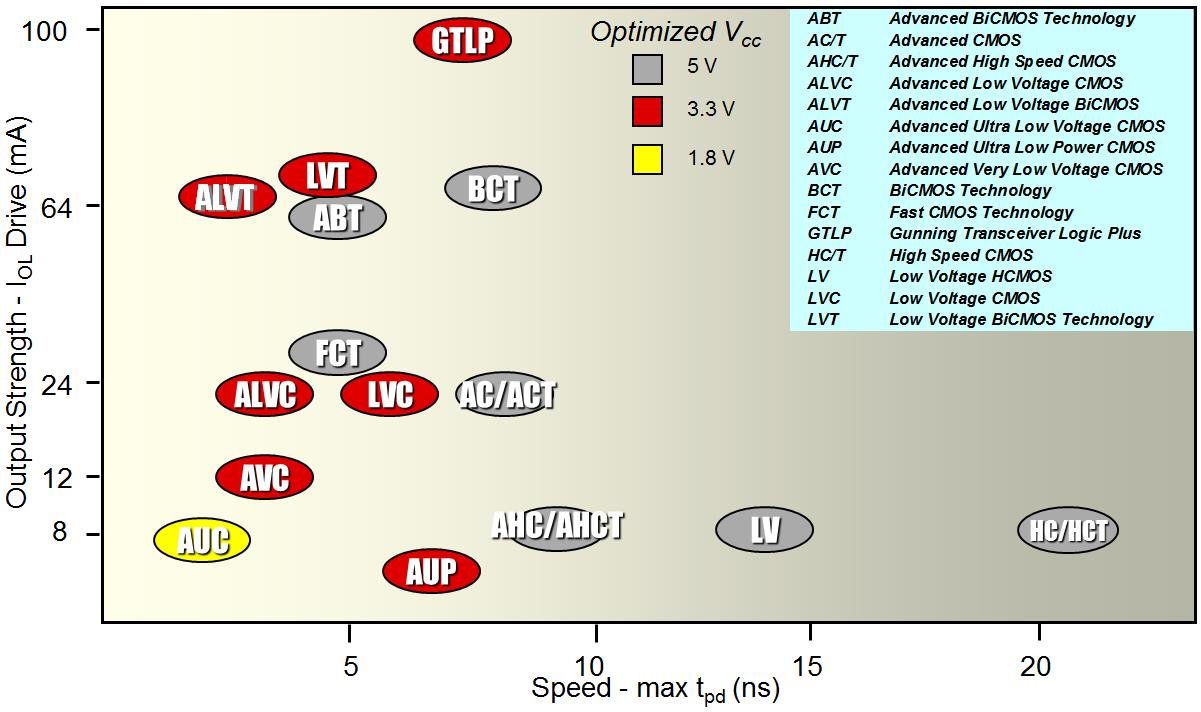SSZTC76 september 2015 SN74AUC00 , SN74HC00 , SN74LV00A
Virtually every electronic system needs a logic device of some kind. And with TI’s large portfolio, we’re able to help with just about any logic need. But with all those devices to choose from, it can sometimes be daunting to choose the correct logic device for a design. Knowing the exact logic function and voltage range you’re looking for helps, but there still may be many devices that generally fit your criteria. So let’s discuss why TI has so many different options, and how to choose the right one for your design.
I’m going to assume that you are familiar with logic terminology such as propagation delay and output drive strength. If you need to brush up a bit, please check out our application note, “Introduction to Logic.”
So, what’s a logic family? A logic family is a group of unique logic devices that operate on a particular technology. For example, the HC family comprises many parts, including negative-AND (NAND) (SN74HC00) gates. You can find NAND gates in practically every logic family we make. For a couple of examples, take a look at the LV family (SN74LV00A) and the AUC family (SN74AUC00). What makes a family unique is not the list of available functions but their electrical characteristics. For full descriptions of each logic family, please read our “Logic Guide.”
Some characteristics that make a family unique are supply voltage, propagation delay, power consumption and output drive strength. Additionally, some families support features such as partial power down, bus hold and overvoltage tolerant inputs. The importance of these features will depend entirely on your system requirements.
Two characteristics that make families unique are the range of supply voltages over which they can be used and their propagation delay. As you can see in Figure 1, there is quite a bit of overlap for both areas, just looking at eight of our logic families.
![Typical Propagation Delay
versus Supply Voltage for Eight Logic Families (Data Taken from Each Family’s
‘125 Device [Buffer/driver]) GUID-83A07DE2-2C0B-4B0F-B6E5-415A7AA4D07D-low.jpg](/ods/images/SSZTC76/GUID-83A07DE2-2C0B-4B0F-B6E5-415A7AA4D07D-low.jpg) Figure 1 Typical Propagation Delay
versus Supply Voltage for Eight Logic Families (Data Taken from Each Family’s
‘125 Device [Buffer/driver])
Figure 1 Typical Propagation Delay
versus Supply Voltage for Eight Logic Families (Data Taken from Each Family’s
‘125 Device [Buffer/driver])Let’s say that you want to select a device that has less than 5ns of propagation delay, and your system operates at 3.3V. Looking at Figure 1, it appears that it would be best to use the LVC, ALVC, AUC or AVC devices. Many would choose a device from the AVC family because it has the lowest propagation delay according to the graphic. But is that really the best one for your system?
Figure 2 offers a more complete picture of our logic families. It adds two pieces of information not available in Figure 1: the optimal supply voltage and output drive strength (IOL) for each family.
 Figure 2 Logic Families Colored for
Optimal Supply Value, Plotted against Typical Output Drive Strength and
Speed
Figure 2 Logic Families Colored for
Optimal Supply Value, Plotted against Typical Output Drive Strength and
SpeedNow you can start to see the separation between families. Figure 1 indicated that ALVC, AUC and AVC were about the same for a 3.3V supply. But Figure 2 shows that AUC is optimized for 1.8V operation, and that ALVC has more drive strength than AVC.
The next step after this would be to go to the data sheets: Compare individual logic devices from the families that appear to fit best and compare those characteristics to your system’s requirements.
To summarize, here’s the best way to select a logic family for your application:
- Identify primary system requirements such as supply voltage, power consumption, maximum propagation delay, output drive strength, etc.
- Select the logic family or families that meet your requirements from the list of families in our “Logic Guide.”
- Compare data sheets for specific devices among the chosen families to determine the best one for your specific application.
- If you are having trouble, feel free to ask us questions in the TI E2E™ Community Logic forum.
Although there are far too many points of comparison for different logic families for me to cover here, it is important that you identify the specific priorities of your system, and focus on those priorities when selecting logic devices. You might only need one capable of running at 2.3V, or you might have a very long and specific set of requirements. Regardless, the wide variety of families available will allow you to choose the exact component that is best for your application.